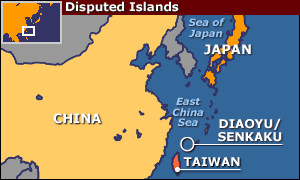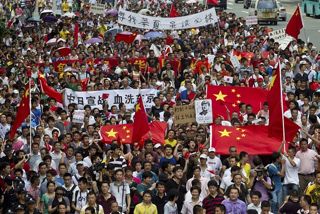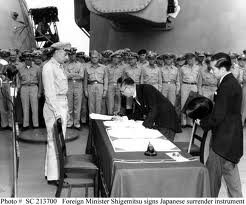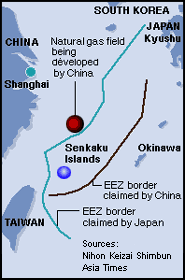A Big Fuss Over Small Islands Posted by sasha on Oct 8, 2012 in Culture, Uncategorized
Unless you’ve been living under a rock for the past month, you’ve probably heard about the dispute between China and Japan concerning a small archipelago of uninhabited islands in the East China Sea. So, what exactly is all of the fuss about? Here is a brief history and explanation for the current state of affairs:
The Islands in Question
Covering an area of just 7 square kilomesters and composed of five uninhabited islands and three large rocks, they lie east of Mainland China, northeast of Taiwan, and southwest of Okinawa, Japan. They are known as the Senkaku Islands in Japanese, and are called the “Fishing Islands” (钓鱼岛 – diào yú dǎo) in Chinese.

Barely noticeable on a map, yet the cause of so much drama.(http://shaunworldronin.wordpress.com/2010/11/01/diaoyu-senkaku-islands-a-lot-of-noise-over-some-formerly-worthless-rocks/)
History
Way back in 1885, the Japanese Governor of Okinawa petitioned the Meiji government to incorporate the islands into Japanese territory. Higher-up officials didn’t want to do so, however, as they knew the islands had a Chinese name and were near the border of the Qing Empire. According to China, these islands have been known to and controlled by China for hundreds of years. They point to a book called Voyage With the Tail Wind (顺风相送 – shùn fēng xiāng sòng) written in 1403 which recorded the names of the islands. By 1534, another book titled Record of the Imperial Envoy’s Visit to Ryukyu (使琉球錄 – shǐ liú qiú lù) had identified and named them all.
Japan claims that after surveying the islands for about ten years in the late 19th century, they were declared to be terra nullius (“land belonging to no one”). After the First Sino-Japanese War – in which Japan was victorious – the islands were officially incorporated into Okinawa prefecture. This came as part of the Treaty of Shimonoseki, which gave Taiwan and “all islands appertaining or belonging to it” to Japan. Many years later, however, at the end of another war which had a very different outcome for Japan (World War II), the Treaty of San Francisco was signed with the Allied Powers. This treaty returned control of Taiwan and all of those other islands back to China. As China was engaged in a civil war at the time, neither the PRC nor the ROC were invited to take part in the talks.
The Dispute
Basically, the argument regarding the islands boils down to whether or not they were actually included in the vague language about Taiwan and “all islands appertaining or belonging to it” in both aforementioned treaties. Japan claims that the islands were uninhabited and unknown before they stumbled upon them, that they were not included in the first treaty, and thus that they could not have been part of the second treaty. They also believe that China only began staking claim to the islands as a result of a UN report in 1969 that stated there may be oil and gas reserves under the island.
On the other hand, China points back to the worried Japanese official (he was the Minister of Foreign Affairs) and his resistance to including the islands as part of Japan’s official territory as evidence that Japan knew the islands were not, in fact terra nullius. As neither the PRC nor the ROC were invited to take part in the talks surrounding the Treaty of San Francisco, they don’t officially recognize it.
Incidents
In 1996, a Japanese activist group built a lighthouse on one of the islands, which enraged their Chinese counterparts, who attempted to sail to the island and destroy it on multiple occasions. There have also been numerous incidents including Japanese patrol boats and Chinese fishing boats. Just a few years ago, a Chinese boat collided with two Japanese coast guard boats, resulting in the arrests of the crew and captain. Several anti-Japan protests erupted in China, and the crew and captain were eventually released. Last month, the Japanese government reached a deal to purchase the islands from private owners, which has been the main source of all of the protests and anger of the past few weeks.

A common sight in China recently. (http://online.wsj.com/article/SB10000872396390443855804577598731289215766.html)
Throughout China, anti-Japan protests have been raging, with throngs of people marching on the Japanese Embassy in Beijing and plenty of other mass gatherings across the country. Japanese flags have been burned, Toyotas have been flipped over, and plenty of sushi restaurants have been destroyed. As China still holds a big grudge against Japan for never officially apologizing for the atrocities committed during WWII, there is plenty of pent up anger – this certainly isn’t all about a few tiny islands. While it seems as if things have calmed down a bit over the past week, with many people in Chinese packing up and heading off for a vacation, it’s certainly not going away. With a big power shift in the Chinese government coming soon, it’ll be interesting to see how this all plays out.
A Financial Times video with a detailed report of protests.
A quick video of a CNN Reporter attempting to get into the middle of protests in Beijing.

Build vocabulary, practice pronunciation, and more with Transparent Language Online. Available anytime, anywhere, on any device.
About the Author: sasha
Sasha is an English teacher, writer, photographer, and videographer from the great state of Michigan. Upon graduating from Michigan State University, he moved to China and spent 5+ years living, working, studying, and traveling there. He also studied Indonesian Language & Culture in Bali for a year. He and his wife run the travel blog Grateful Gypsies, and they're currently trying the digital nomad lifestyle across Latin America.






Comments:
Anthony:
The island is closer to China. Even though Japan owns most of the surrounding islands, Japan should let China have the Islands. They can share the Islands resources. This could be an opportunity for Japan and China to become allies. If China let Japan have the Islands, the Prime Ministers can meet and shake hands. China can continue their business there. If Japan let China have the Islands, China can maybe forgive Japan for past events. People, peace is far greater than what ever that Island has to offer. The devil will be pleased to see bloodshed. So keep fighting put an end to peace. Cause WWIII. You will destroy the world!